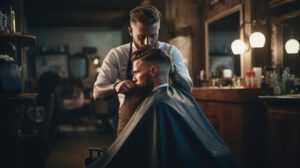How To Take Care Of Your Skin After Shaving
Shaving is a quick and easy hair removal method for both men and women. However, shaving can be a bit rough on the skin.
This is why proper shave care is essential for healthy, beautiful skin. Follow these simple tips from Beepothecary to avoid nicks, razor burns, and dryness after shaving.
Cleansing is vital before any skin care regimen and a shave routine is no exception. Shaving removes excess oils, dirt, and dead skin cells from the face which can clog pores and lead to breakouts. Cleansing can also help slough off any remaining residue left behind from shaving, particularly the soap and aftershave product.
Using a gentle cleanser like Metrin’s #2 lathering cleanser helps to maintain the pH balance of the skin’s acid mantle – keeping the skin clean and healthy, while not stripping it of its natural moisture. This is especially important post-shave when the skin is exposed to irritants and bacteria.
Using an aftershave that contains moisturizing ingredients, such as shea butter or aloe vera, can also have the added benefit of helping moisturize the skin.
Moisturise
Shaving can dry the face, so it’s important to moisturise immediately afterwards. A specialised aftershave balm, lotion or splash can soothe and revitalise the skin and help reduce the risk of nicks and cuts. Some contain antiseptic ingredients to help prevent infection, astringents to reduce skin irritation and perfume, as well as a moisturising element to soften the facial skin. While some men prefer to use their regular face cream or moisturiser after shaving, a dedicated post-shave product may have added benefits. These products can also act as a barrier to protect the skin from irritants and pollution. [3] Avoid using aftershave spray, which can dry and irritate newly shaven skin.
Apply Shave Cream
Shaving cream is like a shaving soap or a lotion that contains glycerin, shea butter and other oils to moisturize the skin. It can be whipped up to a lather or applied using your hands or a brush. It’s important to apply the shaving cream evenly across all areas you plan to shave. This helps to ensure that you don’t miss any spots and can help to reduce the risk of razor burn.
A shaving cream’s emulsifiers and fatty acids soften the facial hair and lift it away from the face, making it easier to cut with your razor. This can also help to reduce the chance of ingrown hairs and red bumps. Most shaving creams are scented with a light and pleasant fragrance that adds to the experience of shaving.
After shaving, the shave cream forms a protective barrier on the skin that can help prevent irritation and infection. This is especially helpful if you have sustained small cuts during your shave because those can become entry points for bacteria.
If your shave cream doesn’t have a built in moisturizing agent, it is a good idea to follow up with an aftershave balm, splash or moisturizer. Look for one that is specially formulated for aftershave use and contains disinfectant to help prevent bumps and redness, as well as a moisturizer to help the skin recover from the irritation caused by shaving. Also remember that since aftershave products are usually made with water, they need to have preservatives in them to keep the ingredients from spoiling. This means that they will have an expiration date. Once the product has expired, it is no longer effective and should be tossed out.
Exfoliate
For a smoother shave, it’s important to exfoliate your skin both before and after shaving. This helps to slough off dead skin cells that can block pores, and promotes healthy, glowing skin.
Ingrown hairs are a common problem that can occur when dead skin cells clog the pores. This can lead to razor bumps and redness. Regular exfoliation prevents ingrown hairs by removing the buildup of dead skin. It also allows for better penetration of the shave cream and helps to achieve a closer shave.
Using a physical scrub or exfoliating product (we like our Exfoliating Body Polish Crushed Macadamia and Rice Milk) is an easy way to help prepare your skin for shaving. Make sure to use a gentle product so you don’t irritate your skin.
Before shaving, spend about 10 minutes in warm water to soften the outer layer of your skin and hair. This makes it easier to remove the hair and reduces your chance of razor burn. Shaving in the shower or bath is a great way to do this, but you can even soak a towel in the warm water.
Once you’ve rinsed and patted your skin dry, you’re ready to exfoliate! Use a physical scrub to slough away the dead skin and then follow up with a nourishing moisturizer.
It’s all about balance and what works best for your skin. For some, it may be easier to exfoliate before shaving, while for others, it may be more convenient to do it after. Experimenting with both options and observing how your skin reacts will help you determine the right routine for you. However, remember to exfoliate only twice a week so you don’t overdo it and cause your skin any damage.
Rinse
Just as warm water opens the pores and relaxes the skin at the start of your shaving routine, splashing cold water on the face at the end helps to close the pores while protecting it from bacteria. Then, pat the skin dry with a clean towel. It is also a good idea to apply an aftershave product that contains moisturizing ingredients, such as aloe vera, natural oils, shea butter or pure and simple aloe vera. These will not only help to rehydrate the skin, but they will also protect it against folliculitis, bumps and redness caused by shaving. Avoid products containing alcohol which can be irritating to the skin.
